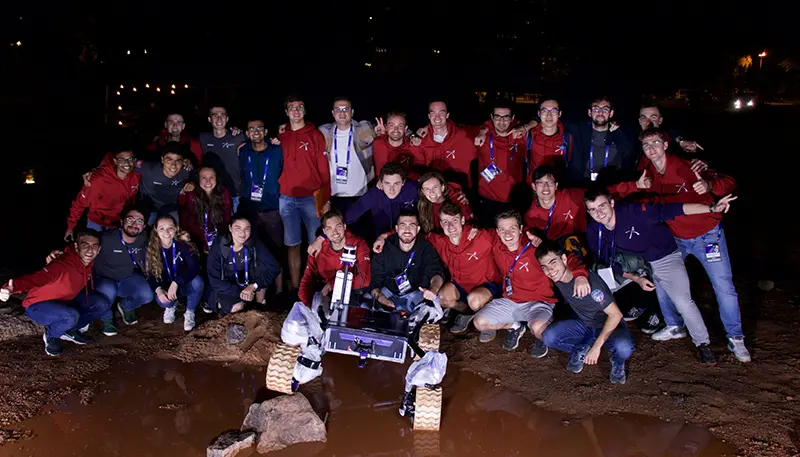背景
Rover robots play a crucial role in space exploration. They act as remote-controlled vehicles that collect valuable data from distant planets and moons. Space exploration involves the use of astronomy and space technology to explore outer space. While astronomers primarily use telescopes for observation, physical exploration relies heavily on unmanned robotic space probes and manned spaceflight.
In this success story, we look at the student group eXplor, which has developed a rover capable of traversing extraterrestrial landscapes, focusing on the role of magnetic encoders in its development and improvement. From the drawing board to final deployment, a blend of innovation, precision engineering and adaptability to the challenges of space is required at every stage, with encoders playing a crucial role.
About Xplore
EPFL Xplore is a student-led space robotics project at EPFL that is part of the MAKE initiative in Switzerland. It's driven by a passionate team of 60 EPFL students who all have the vision to push the boundaries of space exploration and who volunteer their free time to work on this project. Their goal is to develop a rover similar to the Mars rovers of NASA missions.
The group participates in international competitions such as the annual European Rover Challenge, where the students gain valuable hands-on experience in designing, building and operating complex robotic systems. They learn various technical skills such as using and mastering standard software, hardware and procedures, but also interpersonal skills such as leading a team, setting goals and deadlines and dealing with administrative and legal issues.
In their projects, they face similar challenges as real space exploration teams. Ongoing efforts are critical as they create a steady pipeline of skilled professionals ready to meet the evolving needs of the space industry. By working on these projects, students advance space technologies, foster innovation and help maintain a competitive edge in global space missions.
課題
To meet the need for accurate motion feedback, the team integrated RLS magnetic encoders into the mechanical joints of the robot arm, enabling the 6DOF (degrees of freedom) and the steering joints of the rover. Precise positions of the joints of the robot arm are necessary to implement inverse kinematics algorithms. Thanks to these, the arm is able to perform complex manipulations autonomously with relative ease and speed. Manual control of the arm is also very natural for the operator.
The experience of working with RLS was great, the products always worked as expected and when there were issues, the support was always very responsive!Louis Flahault, CFO of Xplore
解決策
EPFL Xplore used Orbis encoders because they are very easy to install and mechanically robust. Orbis is a true absolute encoder that is ideal for applications where a typical OnAxis encoder cannot be mounted or that require a hollow shaft. With features such as 14-bit resolution, multiturn counter option and integrated self-diagnostics, it ensures precise performance.
Its wide installation tolerances with integrated status LED allow for easy installation. The through-hole design and its robustness make Orbis ideal for robotic applications such as 4-legged robots, AGVs or robotic arms. Orbis absolute encoders provide motion and speed feedback to the motors that move the robot's parts. With the encoders, the robot system can position the motors extremely accurately and with consistent repeatability.
On the other hand, AksIM is an exceptional off-axis absolute encoder designed for applications with limited space. Equipped with communication interfaces such as BiSS, UART, SPI, PWM or SSI and with a resolution of up to 20 bits per revolution, it ensures precise performance. With features such as a customised magnetic sensor ASIC, a self-calibration option, no hysteresis and high repeatability, it ensures reliable operation. AksIM is shock and vibration resistant and, with a temperature range of −40°C to +105°C, is suitable for industrial and medical applications. Its low profile, non-contact design ensures optimum performance.
A typical AksIM application is a collaborative robot. No matter how excellent the design of the robot is, it still depends on its components to achieve maximum functionality. The AksIM encoder is often used for real-time position tracking of the individual joints and plays a crucial role in the accuracy of the robot.
今後の目標
Xplore continues to develop and expand its focus for the future. The team has already won 3rd place overall at the on-site edition of ERC 2021 and 2nd place overall at ERC 2022. Now it is shifting focus from purely competition-oriented projects to building closer relationships with EPFL labs and leading technical partners such as RLS. In the future, they want to carry out more comprehensive robotics projects that will not only impact future competitions, but also expand their knowledge and expertise in the field.
About EPFL Xplore
PFL Xplore is a interdisciplinary project whose aim is to build a Rover in order to participate in two international competitions: University Rover Challenge in the US and European Rover Challenge.
For more information about EPFL Xplore visit: epfl-xplore.ch



